Sales Leaderboard Software: Boosting Productivity & Defeating Burnout
The use of leaderboards for sales performance tracking has its roots in traditional sales contests and incentives. In the past, sales managers would manually keep track of sales numbers and rank their reps based on their performance.
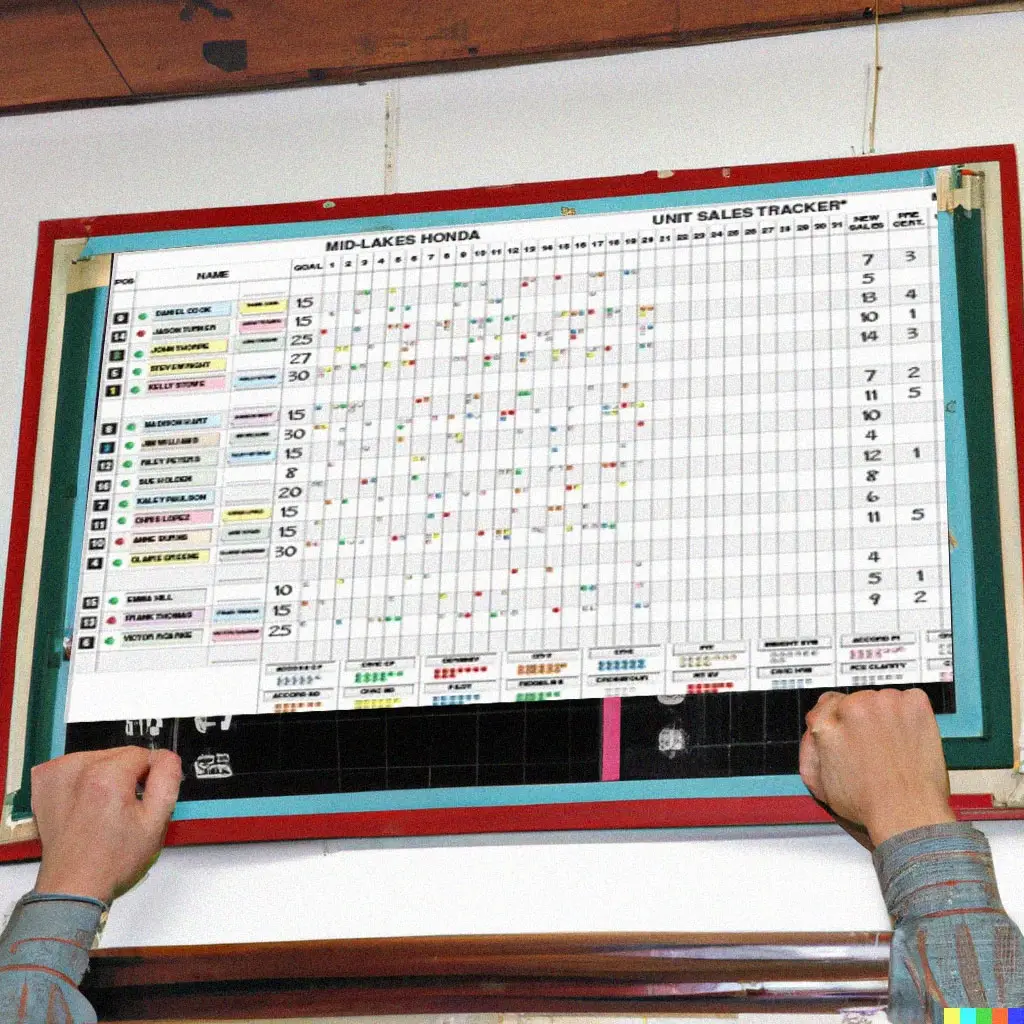
Old school car salesmen leaderboard
With the rise of technology, sales leaderboards have evolved into digital tools that can track and display sales performance in real-time. These software systems automate the process of tracking key metrics and enable managers to view and analyze sales performance data at a glance. The popularity of sales leaderboards has grown rapidly in recent years with the proliferation of cloud-based software and mobile devices. Today, sales leaderboards are widely used by organizations of all sizes to increase sales productivity and motivation.

Modern sales leaderboard software apps
What Is Sales Leaderboard Software?
Whether you call it sales leaderboard software, a sales leaderboard app, or a sales leaderboard dashboard, it is a tool used by organizations to track and monitor the performance of sales teams. Inspired from sports and other games, sales managers use it to try and create a competitive environment by ranking sales reps based on metrics such as revenue generated, deals closed, and touchpoints made. In software form, they are often presented to managers and reps within a web application, a mobile app, and various sales dashboards. At a high level, sales leaderboards enable reps to see how they are performing in comparison to their peers.

This leads us to the core idea of a leaderboard, which is to leverage social comparison mechanics from behavioral psychology to boost output. Social comparison theory suggests that we value our personal + social worth by assessing how we compare to others. Specifically, sales leaderboards typically use upward social comparison. This takes place when reps compare themselves with those who they believe are better than them. These upward comparisons often focus on the desire to improve their current status or level of ability. They may compare themselves to someone better off and look for ways that they can achieve similar results.
Thus, sales leaderboards serve as a platform for measuring success, fostering healthy competition, and driving continuous improvement within a sales organization, identifying top performers and areas for improvement within the team.
Traditional Sales Leaderboard Software & Dashboards
Most sales leaderboards tacked onto business software & dashboards are a basic list of reps usually ranked by total sales. However, this crude approach predictably ends up only motivating the top few because each week/month/quarter, the same subset of reps often end up at the top of the rankings. For the rest of the team, it's not very motivating to constantly end up in the middle or bottom of the leaderboard feeling like you have no chance of winning or being recognized for your performance. Reps end up feeling that their hard work goes unnoticed as the focus is solely on the top performers on the leaderboard. This symptom of basic sales leaderboards is the main contributing factor to what's known as leaderboard burnout.
Leaderboard burnout is a phenomenon where the continuous use of sales leaderboards to track and monitor performance can lead to negative consequences such as decreased motivation, morale, and job satisfaction among sales reps. In addition to the behavior described above, leaderboard burnout is accelerated when reps feel that their performance is being constantly monitored and that they are under intense pressure to perform, leading to increased stress. Additionally, leaderboard burnout can quicken when reps feel that the metrics used to rank them are not a fair representation of their efforts or that the stakes are too high.
At a basic level, to avoid leaderboard burnout, it is important for organizations to use sales leaderboards with care and ensure that the metrics used for ranking reps are fair and relevant. Managers should also regularly communicate with reps to understand their needs and concerns, and take steps to address any issues that may be contributing to burnout. However, there are a number of advanced tactics that you can deploy to more effectively defeat leaderboard burnout. More on that in a minute.
Modern Apps Applied To Sales Leaderboards
Modern software and apps have greatly enhanced the functionality and capabilities of sales leaderboards, making them more effective and user-friendly. Some of the ways modern software has improved sales leaderboards include:
-
Real-time tracking and updates: With modern software, sales leaderboards can provide real-time updates on performance, enabling reps to instantly see how they are doing in comparison to their peers.
-
Customizable metrics: Modern leaderboard apps allow sales organizations to track a wide range of metrics, including revenue generated, deals closed, touchpoints logged, events planned, tasks completed, etc and even to fully customize the metrics used for ranking.
-
Data analysis and reporting: Today's sales leaderboards provide managers with detailed data analysis and reporting capabilities, enabling them to better understand sales performance trends and identify areas for improvement.
-
Mobile compatibility: With the rise of mobile devices, many leaderboards are now designed to be compatible with mobile devices, allowing reps to access performance data and updates from anywhere, at any time.
-
Integration with other tools: Many sales leaderboards now integrate with other sales tools and business applications, such as customer relationship management (CRM) systems, sales enablement platforms, and other KPI sources, making it easier for orgs to access and update performance data.

Overall, modern software and apps have significantly enhanced the functionality and capabilities of sales leaderboards, making them more effective tools for driving sales performance and motivation. But the vast majority do not address the fundamental issues of leaderboard burnout previously discussed, because at their core they are still just a basic leaderboard.
How The Best Sales Leaderboards Level Up
The best leaderboards introduce mechanics to create competition not only at the top, but also at other levels of the rankings. Let's put sales orgs aside for a moment and look to professional sports for a couple concrete examples. A simple example occurs at most PGA golf tournaments.

A standard stroke play tournament is played in four days from Thursday to Sunday and after 2 days (36 holes), "the cut" occurs where the top portion of players make the cut and advance to play Saturday and Sunday. This additional level of competition to the golf tournament leaderboard provides motivation and incentive for players in the middle of the pack to try and make the cut, earn more money, and stay alive for winning the title. For viewers it also provides a little extra excitement at the midpoint of the tournament.
The English Premier League and other European football (i.e. soccer) leagues take it to another level...well 10+ more levels. The UK uses a "football pyramid" of league levels where the Premier League sits alone at the top.
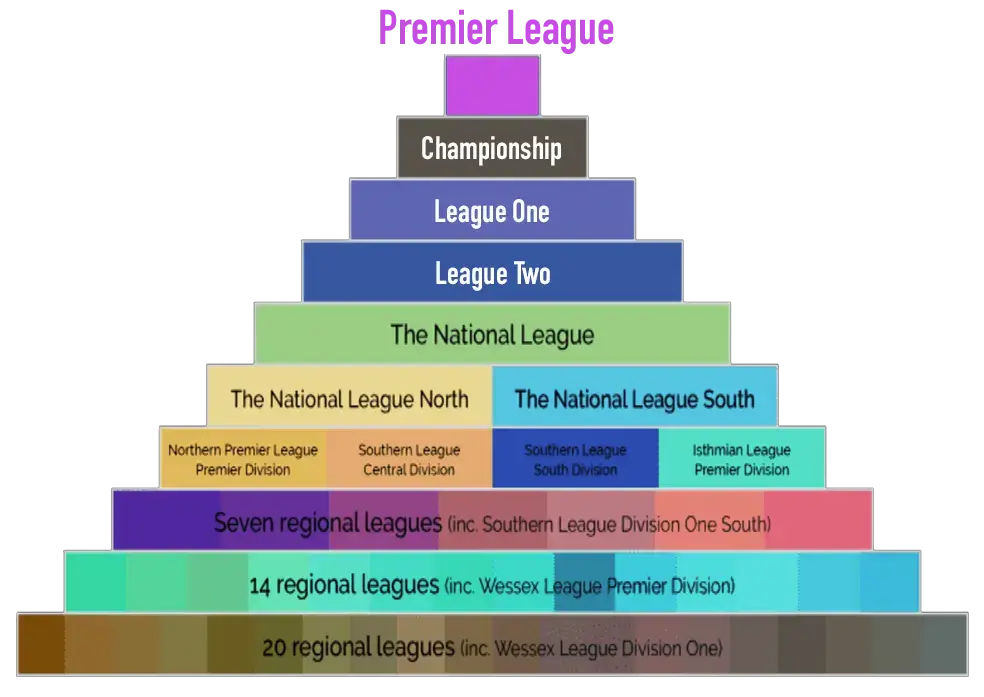
Then after each season, the top and bottom few teams in each league's rankings are promoted up a league or relegated down a league. With this system, even the smallest clubs in the country can theoretically rise to the very top league (and sometimes do in epic fashion). This system provides a number of advantages for both the competing teams as well as the fans:
-
Increased competition: The threat of relegation adds pressure for teams near the bottom of the table to perform, leading to more intense and competitive matches.
-
New teams: The promotion of teams from the lower leagues introduces new competition to the Premier League and can create new rivalries.
-
Relegation battles: Teams fighting to avoid relegation provide additional drama, adding to the excitement of the end of the season.
-
Financial rewards: The financial benefits of playing in the Premier League, such as increased revenue and sponsorship opportunities, drive teams to fight hard for promotion and avoid relegation.
Overall, the promotion and relegation system adds to the excitement of UK and European football by creating a dynamic and constantly evolving league with new challenges and storylines for fans to follow. Contrast this system to the big four American sports (NFL, NBA, MLB, and NHL) where the middle and bottom teams have nothing to play for near the end of the season, no one watches their games, and those teams even experience reverse motivation to try to finish last to get the top draft pick for next season. Swing and a miss.
Now let's bring it back to sales leaderboards. The above mentioned tactics as well as others enabled by software have recently began showing up in advanced sales leaderboards. For example, if you have enough reps, splitting up your sales leaderboard into say 3 levels and implementing a promotion + relegation system is a great way to help defeat leaderboard burnout and increase engagement.
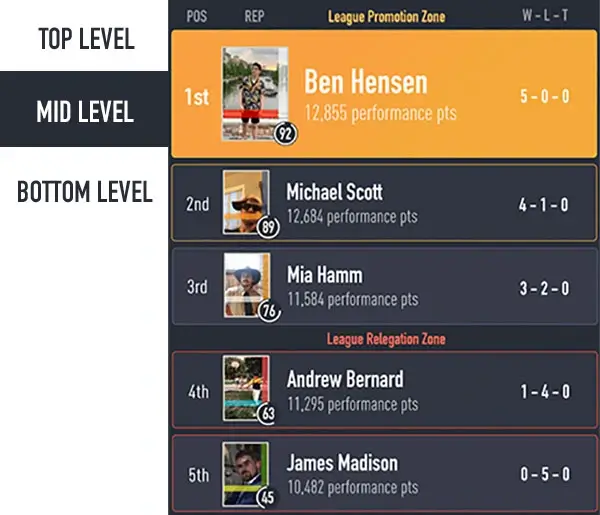
It gives reps at the top and bottom of each leaderboard something to play for, which positively affects the reps who would have been in the middle of your basic combined/mega leaderboard. Furthermore, it allows for a more storied journey for your new reps to rise through the levels and ranks as they improve.
Other major improvements to traditional leaderboards continue to build upon this trend of expanding the number of entry points for competition. In other words, add more ways for your reps to compete. Competing against yourself is another one. For example, within the leaderboard there can be a spot for your "shadow" from last week to see if you can outperform your past self and improve this week. Your shadow self from last week can even appear to earn dollars/deals/touchpoints/etc at the same pace this week as they did last week, so you are not simply striving to hit a fixed total, rather you can see at any time if you are ahead or behind your shadow as the week progresses. It turns out that this is a great approach to improve reps near the bottom of the leaderboard because it feels much more attainable to build on your past performance one step at a time compared to feeling like you need to make a large jump to get to the top of the board.
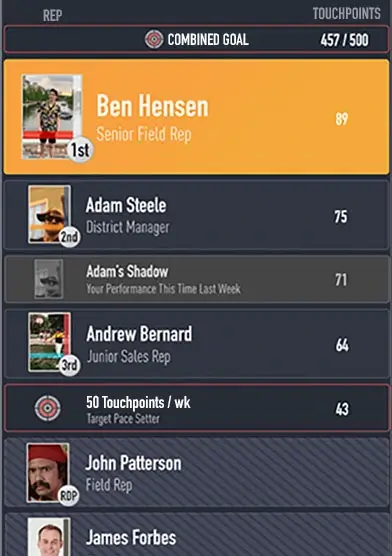
There are a number of other strategies that the best sales leaderboards use, such as competing against quotas & goals right on the leaderboard and ranking reps based on a custom set of weighted metrics to better capture total performance. But now let's look beyond leaderboards at even better ways to make it more rewarding for your team to improve & perform well.
Beyond Leaderboards
It turns out that leaderboards aren't the only way (or even the best way) to use competition to boost sales performance. Again taking inspiration from golf, in addition to the standard stroke play tournament that uses a running leaderboard, there are a number of other types of golf competitions:
-
Stroke Play: This is the most basic format of golf competition, where the player with the lowest score over a specified number of holes or rounds wins.
-
Match Play: In this format, two players or teams compete against each other hole by hole, with the player or team that wins the most holes declared the winner.
-
Best Ball: A type of competition where a team of two or more golfers play their own ball and take the best score on each hole.
-
Scramble: A type of competition where a team of golfers play a single ball and take the best shot from each player on each hole.
-
Alternate Shot: A type of competition where two players take turns hitting shots and playing the same ball.
-
Bogey Competition: A type of competition where the goal is to score as close to one over par on each hole as possible.
-
Stableford: A type of competition where points are awarded based on a player's score on each hole, with higher scores awarded for better performances.
-
Pro-Am: A type of competition where professional golfers play alongside amateur golfers.
Each of these formats offers a unique challenge and requires different strategies and skills, making golf a diverse and exciting sport for competitors and fans alike. Now imagine a version of each of these applied to sales organizations. For example, in addition to leaderboards, you could have a round-robin season of head-to-head matchups between your reps and the best win-loss-tie record at the end of the quarter wins an incentive or other reward. Weekly matchups have many advantages over leaderboards such as increased variability each week, more incentive to engage with your opponent, and more chance for wins.
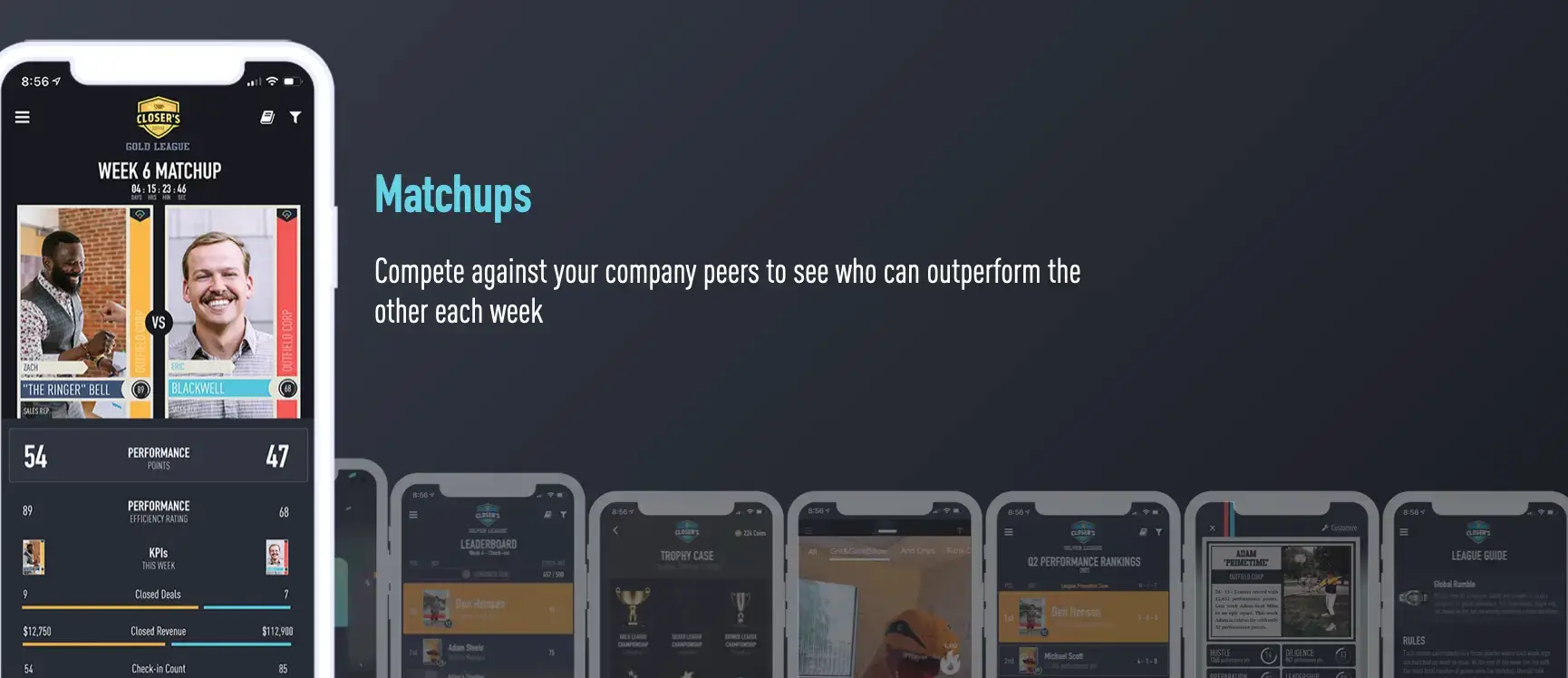
Another opportunity to go beyond leaderboards is through multiple levels of incentives and rewards. There are far more opportunities to reward performance than a winner of a leaderboard. For example, rewarding the most improved rep, breaking a company record, going on a hot streak, top performer for each KPI, mystery/surprise rewards, first sale, first big sale, biggest comeback, etc. And then on top of that is the design and variety of incentives and rewards you give out. Of course there are the obvious things like bonuses and promotions, but there are many more variations that tap into recent knowledge about employee drive and motivation. It turns out the strongest motivation lies within 3 categories: mastery, autonomy, and purpose. So for example, for employees with strong leadership and autonomy drive, perhaps winning the opportunity to lead a new company initiative. Or for an employee with a desire to learn, perhaps acceptance into an internal mentoring program from the CEO. Or for an employee who has strong family purpose with kids that love Disney, perhaps an exclusive VIP trip to Disneyland. Or if they value a particular charity or cause, donate company resources to the cause. Think "The Walter Payton Award." You get the idea (check out this post for more ideas). Obviously, it's important to evaluate in your case which rewards should be baked into company culture and which should be offered as performance incentives.

Finally, don't underestimate the power of notoriety. Yes, basic leaderboards award a degree of notoriety within the organization for the rep at the top. But the best performance systems pour gas on this fire. Some sales performance software is pioneering more opportunities for notoriety not only within your company, but also your industry or even the sales profession as a whole. For your company, you could create a company SportsCenter-like report motivating reps to make the highlights. Or just keep it simple and celebrate goal completion. More on notoriety in a future post.
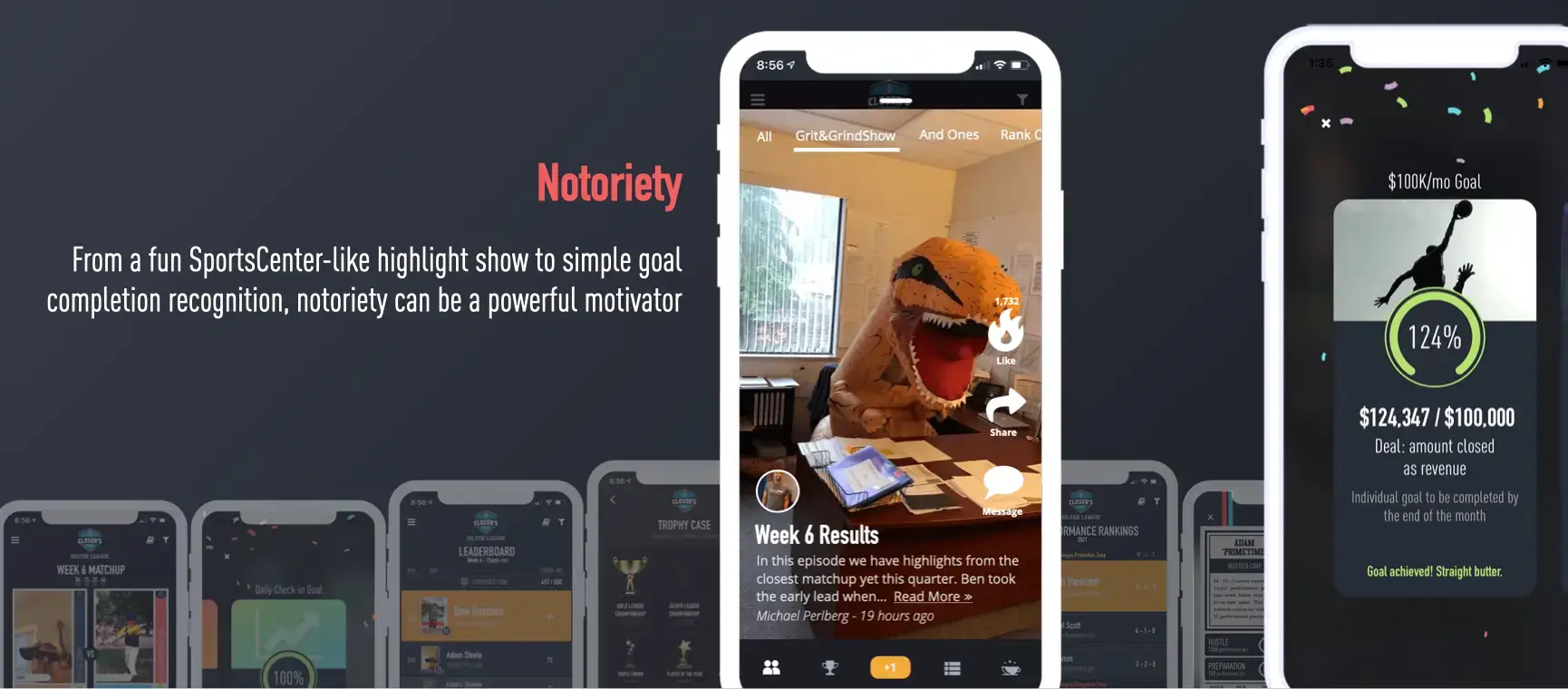
From leveling up to higher sales leaderboards/leagues/tiers, tailoring achievement challenges, finally beating a matchup rival, or busting out an 8 week streak of self improvement, there are a wide range of modern strategies you can deploy to level up from basic leaderboards. With multiple levels of competition & challenge, create a "game mode" for everyone. Whether you start small or aim straight for the top, hopefully the strategies and techniques we've discussed above help you boost employee engagement and productivity while hammering leaderboard burnout for good.
Outfield is pioneering performance-based CRM with the industry's leading sales gamification software. Learn how our modern approach boosts output up to 3x.
SalesGamificationBusinessSoftware